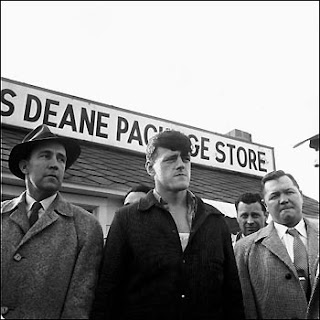Joseph Taborsky
Sentenced
to death and set free to kill again
by Robert A. Waters
Joseph Taborksy could never quite get it
right. A hardened criminal with a cocky attitude, he even got a second chance
after being sentenced to death. Walking
out of prison on a technicality, “Mad Dog” Taborsky informed the press that he
was done with crime.
Even as a youngster, Joe was an
incorrigible little brat. His first recorded crime was the theft of a
bicycle. Released with no time served,
he pilfered another bike. He eventually
served a few months in a reform school for theft, but it didn’t help. Throughout his teens, Taborsky, a part-time
boxer, learned to bob and weave through the justice system, escaping punishment time and again.
Born in Hartford, Connecticut in 1926,
Joe came from a middle-class family. His
father, a door-to-door salesman, worked hard to keep his family afloat while
Joe’s mother kept house. In addition to Juvie
Joe, there was Albert, dull of intellect and certifiably insane.
At 18, while serving a short sentence in the local
jail, Joe escaped. After being
re-captured, he finally did hard time—three years in the state
penitentiary. Upon his release, he fled
to Seattle, Washington. True to his
nature, Joe began burgling houses and, in 1947, served a short sentence for his
crimes. Returning to Connecticut, the
career criminal did a six-month stint in the Hartford City Jail for carrying an
illegal weapon. In the next few years, he
racked up arrests for burglary, robbery, and other offenses. In most of those cases, he avoided prison.
Then, according to the North Adams Transcript, Joe hit the big
time. “In January 1951, [Joseph]
Taborsky arrived on the public scene with a spectacular burst of notoriety. His
mother, Mrs. Esther M. Taborsky, called police and said her son Albert would
like to talk to officers. Albert said he and Joe parked near a liquor store one
day and Joe got out with a gun. When he returned, Joe said: ‘The guy jumped me
and I had to shoot him.’ The store operator turned out to be Louis I. Wolfson,
whose murder police had been trying to solve for months. A month later, Joe was
found guilty of first degree murder and his execution was set for Nov. 7,
1951.” Albert pleaded guilty, testified against his brother, and drew a life
sentence.
In 1955, Joe received a stroke of luck
that might have turned his life around.
During his incarceration, Albert had been committed
to an insane asylum. Because of this,
Joe’s attorneys appealed his death sentence,
alleging that a crazy man’s testimony couldn’t be used in court. The justices agreed. Suddenly, the prison doors swung open and a
grinning Joseph Taborsky was released once again to prey on society.
On December 15, 1956, cops found Edward
J. Jurpiewski and Daniel J. Janowski murdered in their rural service station. Then Samuel
H. Cohn was killed in his liquor store.
Next, Bernard J. Speyer and his wife, Ruth, died. They happened to walk into a shoe store as
it was being robbed. Finally, the
bandits stuck up a pharmacy and killed John M. Rosenthal. Most of Taborsky’s victims were forced to
kneel on the floor, then shot in the head.
With the bodies piling up, cops finally
got a break. The shoe store owner had been
beaten but survived—he told detectives that the killer had pretended to be a
customer and asked for size 12 shoes.
Investigators looked through their crime files and came up with the name
of only one offender who wore that size shoe. Joseph
Taborsky.
“Mad Dog” and his partner, Arthur “Meatball” Culombe, confessed to
murdering six people. In total, their deadly
heists netted only a few hundred dollars.
At trial, Culombe, called a “mental defective” and “moron,” got life in
prison. Taborsky was once again
sentenced to death.
This time the sentence would be carried
out. On May 17, 1960, Taborsky was strapped into Connecticut’s electric
chair. As the switch was thrown, his
body snapped back, then he went limp.
He donated his remains to Yale Medical
School and his eyes to a New York eye bank.
If he hoped to make up for the number of ruined lives that followed in
his murderous wake, he failed. Nothing
could atone for the innocent victims he killed.











